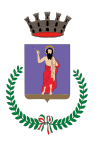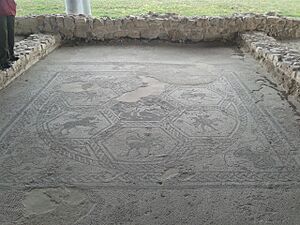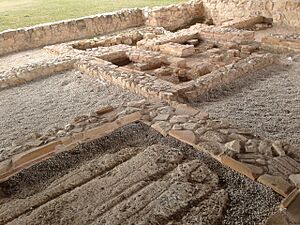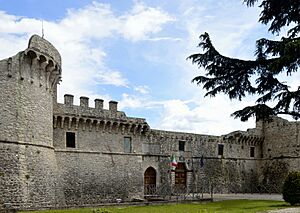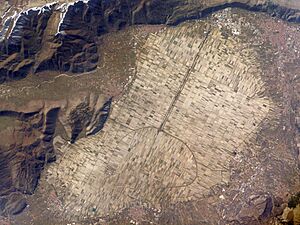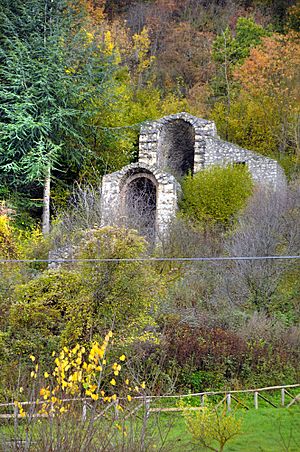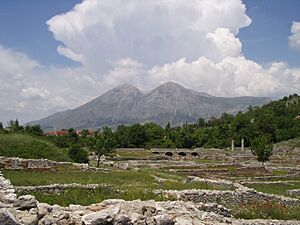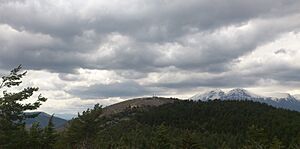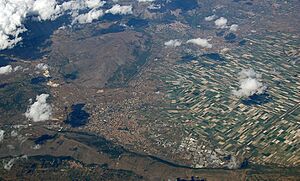Avezzano facts for kids
Quick facts for kids
Avezzano
Avezzàne (Neapolitan)
|
||
|---|---|---|
| Città di Avezzano | ||
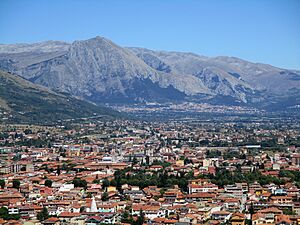
View of Avezzano from Mount Salviano
|
||
|
||
| Country | Italy | |
| Region | Abruzzo | |
| Province | L'Aquila (AQ) | |
| Frazioni | Antrosano, Castelnuovo, Cese dei Marsi, Paterno, San Pelino, San Giuseppe di Caruscino, Borgo Incile, Borgo Via Nuova | |
| Area | ||
| • Total | 104.08 km2 (40.19 sq mi) | |
| Elevation | 695 m (2,280 ft) | |
| Population
(30 June 2024)
|
||
| • Total | 40,893 | |
| • Density | 392.900/km2 (1,017.61/sq mi) | |
| Demonym(s) | Avezzanesi | |
| Time zone | UTC+1 (CET) | |
| • Summer (DST) | UTC+2 (CEST) | |
| Postal code |
67051
|
|
| Dialing code | 0863 | |
| Patron saint | Bartholomew the Apostle and Madonna di Pietraquaria | |
| Saint day | 24 August and 27 April | |
Avezzano is a city located in the Abruzzo region of Italy. It's in the province of L'Aquila and is the second largest city there. Avezzano is a very important place for business, industry, and farming in the Marsica area. It's also home to some cool high-tech companies and the Fucino Space Centre.
The city has faced tough times. It was almost completely destroyed by a huge earthquake in 1915. Later, it was rebuilt, but then damaged again by Allied bombings in 1944 during World War II. Despite these challenges, the city was rebuilt and even received a special award from the Italian Republic for its strength.
Contents
Avezzano's Story
What's in a Name?
The name "Avezzano" has a few possible origins. Some say it comes from "Ad Vetianum," meaning "to the Vetia family." Others think it's from "Avidianum," or "fundus Avidianus," which might be linked to a noble family called Avidius who lived nearby. A more fun idea is "Ave Jane," which was a greeting to the Roman god Janus.
Early Beginnings
People have lived in the Avezzano area for a very long time! We know this because tools and signs of hunters from the Stone Age (about 18,000 to 14,000 years ago) have been found here. There are also traces of ancient burial grounds from around 800-500 BC, showing that people were settled here even before the Romans.
Roman Times
Avezzano was once a farming area connected to Alba Fucens, a town founded by the Romans around 304-303 BC. The Romans built many large country houses, called villa rustica, in this region. One important villa, the Roman Villa of Avezzano, dates back to the 2nd century BC.
The first big settlements in this area really grew after the Romans, led by Emperor Claudius, started draining the huge Lake Fucino in 52 AD. This made a lot of new land available for farming and living.
The Roman Villa of Avezzano
The Roman villa in the Macerine area opened to visitors in 2008. It was built around 200 BC and covered a large area. This farm was used by settlers to grow crops for the nearby Roman town of Alba Fucens.
The villa had many rooms, including living areas for the owner and servants. There were also special areas for collecting and storing oil and wine. Over time, the villa became even grander, adding private baths with heating systems and beautiful mosaic floors. One mosaic shows a winged victory on a chariot pulled by two horses. The villa was used until the early 500s AD, when it was likely abandoned after an earthquake.
The Middle Ages
After the Roman Empire, the area around Avezzano came under the control of the Duchy of Spoleto in 591. Later, in the 700s, Charlemagne gave these lands to the papal states, creating the county of the Marsi.
In the late Middle Ages, a big battle took place nearby in 1268, called the battle of Tagliacozzo. After this, Avezzano grew as different small villages joined together to form the city we know today.
From Castles to Earthquakes
In the 1400s, Avezzano was ruled by the Orsini family. They built the famous Orsini-Colonna Castle in 1490. Later, the Colonna family took over, and they expanded the castle in 1565, turning it into a fancy fortified palace.
Avezzano used to be right on the edge of Lake Fucino, which was the biggest lake in central Italy. But in the late 1800s, the lake was completely drained. This created huge, fertile fields for farming, and the area grew very quickly.
However, on January 13, 1915, Avezzano was hit by one of the worst earthquakes in Italian history. The city was almost completely destroyed, and over 30,000 people died. Only a few buildings, like a part of the Orsini-Colonna castle, survived. After this disaster, the city was rebuilt with straight, wide streets and green areas.
During both World War I and World War II, a camp for war prisoners was located near the city. Avezzano was freed by New Zealand soldiers on June 10, 1944, during World War II.
Where is Avezzano?
Avezzano is located north-west of the Fucino plain. To the north, you can see Mount Velino, and to the west, Mount Salviano. Avezzano is considered the main city of the Marsica area, which includes 37 towns and about 134,000 people.
The city is about 100 kilometers (62 miles) east of Rome, 110 kilometers (68 miles) west of Pescara, and 55 kilometers (34 miles) south of L'Aquila.
City Layout
The old part of Avezzano is centered around the Orsini-Colonna Castle. To the east, the city spreads out to the villages of San Pelino and Paterno. The city sits at an elevation of about 695 meters (2,280 feet) above sea level.
Some of the neighborhoods in Avezzano include Barbazzano, Borgo Angizia, Centro città (city center), and San Rocco.
What's the Weather Like?
Avezzano has a special "Mediterranean mountain climate" because it's in the former bed of Lake Fucino and surrounded by tall hills. In January, the coldest month, the average temperature is about 2.0 °C (35.6 °F). In August, the hottest month, the average temperature is about 20.5 °C (68.9 °F). Sometimes in summer, temperatures can go above 30 °C (86 °F).
| Climate data for Avezzano, elevation 708 m (2,323 ft), (1951–2000) | |||||||||||||
|---|---|---|---|---|---|---|---|---|---|---|---|---|---|
| Month | Jan | Feb | Mar | Apr | May | Jun | Jul | Aug | Sep | Oct | Nov | Dec | Year |
| Record high °C (°F) | 19.0 (66.2) |
21.6 (70.9) |
24.6 (76.3) |
28.6 (83.5) |
33.4 (92.1) |
35.5 (95.9) |
38.5 (101.3) |
37.5 (99.5) |
35.5 (95.9) |
30.0 (86.0) |
24.4 (75.9) |
18.5 (65.3) |
38.5 (101.3) |
| Mean daily maximum °C (°F) | 7.3 (45.1) |
8.8 (47.8) |
12.3 (54.1) |
15.7 (60.3) |
20.4 (68.7) |
24.4 (75.9) |
28.0 (82.4) |
28.3 (82.9) |
24.0 (75.2) |
18.8 (65.8) |
12.5 (54.5) |
8.2 (46.8) |
17.4 (63.3) |
| Daily mean °C (°F) | 2.9 (37.2) |
4.1 (39.4) |
6.9 (44.4) |
10.0 (50.0) |
14.3 (57.7) |
17.9 (64.2) |
20.9 (69.6) |
21.1 (70.0) |
17.6 (63.7) |
13.1 (55.6) |
7.8 (46.0) |
4.1 (39.4) |
11.7 (53.1) |
| Mean daily minimum °C (°F) | −1.5 (29.3) |
−0.6 (30.9) |
1.4 (34.5) |
4.3 (39.7) |
8.1 (46.6) |
11.4 (52.5) |
13.7 (56.7) |
13.9 (57.0) |
11.2 (52.2) |
7.4 (45.3) |
3.0 (37.4) |
0.0 (32.0) |
6.0 (42.8) |
| Record low °C (°F) | −21.0 (−5.8) |
−15.6 (3.9) |
−10.9 (12.4) |
−7.0 (19.4) |
−2.0 (28.4) |
2.0 (35.6) |
4.5 (40.1) |
4.1 (39.4) |
−1.5 (29.3) |
−4.0 (24.8) |
−10.5 (13.1) |
−14.0 (6.8) |
−21.0 (−5.8) |
| Average precipitation mm (inches) | 66.3 (2.61) |
71.4 (2.81) |
61.1 (2.41) |
60.0 (2.36) |
51.0 (2.01) |
44.0 (1.73) |
29.8 (1.17) |
37.5 (1.48) |
57.2 (2.25) |
77.6 (3.06) |
110.2 (4.34) |
99.3 (3.91) |
765.4 (30.14) |
| Average precipitation days | 7.8 | 8.3 | 8.4 | 8.7 | 7.9 | 6.4 | 4.1 | 4.5 | 6.0 | 7.8 | 9.2 | 9.7 | 88.8 |
| Source: Regione Abruzzo | |||||||||||||
Cool Places to See
Since Avezzano was mostly destroyed by the 1915 earthquake, it doesn't have many very old monuments like some other Italian cities. However, you can still find important historical sites!
Orsini-Colonna Castle
The castle was built in 1490 by Gentile Virginio Orsini. It was built around an even older tower from the 1100s. The castle is square with round towers at each corner. Later, in the 1500s, Marcantonio Colonna made it bigger and more elegant. Even though it was badly damaged by the 1915 earthquake, parts of it have been restored since the 1990s.
Tunnels of Claudius
South of the city, you can find the ancient tunnels built by the Roman Emperor Claudius between 41 and 52 AD. These tunnels were part of his big plan to drain Lake Fucino. It took 25,000 slaves to dig these tunnels! The lake was mostly drained, but after the Roman Empire fell, the tunnels got blocked, and the lake filled up again. Many centuries later, Alessandro Torlonia finished the job, finally draining Lake Fucino and turning the land into a fertile plain. In 1977, the tunnels became an archaeological park that you can visit.
Cathedral of San Bartolomeo
The original Cathedral of St. Bartholomew was built around the year 1000. After it was destroyed in the 1915 earthquake, a new one was built after 1940 in Avezzano's new central square. The front of the church is made of travertine stone. Above the three main entrances are mosaics showing Christ, the Virgin Mary, and St. Bartholomew, who are the protectors of Avezzano. Inside, the church has three large sections and a beautiful organ.
Sanctuary of the Madonna di Pietraquaria
The first church here was destroyed in 1268 after the battle of Tagliacozzo, but it was rebuilt centuries later. This church was lucky in 1915; it wasn't badly damaged by the earthquake and even provided shelter for many people who survived.
Alba Fucens
About 7 kilometers (4.3 miles) north of Avezzano is the ancient Roman site of Alba Fucens. Rome founded this colony between 304 and 303 BC. It was in a very important spot, on a hill near the old Roman roads that connected Rome to the Adriatic regions. Archaeologists from Belgium have been digging here since 1949, uncovering its secrets.
Nature Reserve of Mount Salviano
This nature reserve was created in 1999 and covers 722 hectares (about 1,784 acres) west of Avezzano on Mount Salviano. It's home to many different kinds of plants and animals. In the middle of the reserve is the Sanctuary of the Madonna of Pietraquaria, surrounded by trails that are popular with hikers and nature lovers.
- Fucine Inlet
- Torlonia Palace
- Torlonia Square
- Church of San Giovanni
- Liberty Justice Palace
How Avezzano Makes Money
Farming
The farms in the Fucino plain are known for their high-quality vegetables. The Fucino potato is especially famous and has a special "Protected Geographical Indication" label, meaning it's a unique product from this area. Other popular vegetables include carrots, radishes, and various salads. A quarter of all the money made from farming in the Abruzzo region comes from the Fucino plain!
Industry
Just outside the city, there's a big industrial park built in the 1970s. It's like the economic heart of the province, with many factories and businesses. Some of these are huge electronics companies like Micron Technology and L-Foundry, which make very specialized products. About 1,600 people work at the "Innovation & Technology" center in Avezzano. Other companies here include Arab TV, the Burgo group, and FIAMM.
Nearby, in the Fucino plain, you'll find the Fucino Space Centre. This is one of the world's major centers for satellite services.
Commerce
Shopping and services are also very important for Avezzano. There are large shopping areas along Tiburtina Valeria street and XX Settembre street. The city center also has many shops and businesses, creating a "natural shopping center."
Tourism
Avezzano is a great base for exploring the beautiful natural areas and towns in the Abruzzi mountains. Nearby, you can visit the National Park of Abruzzo, Lazio and Molise, the Sirente-Velino Regional Park, the Fucino plain, and various valleys like the Giovenco valley and Roveto valley. There are also charming towns like Ovindoli and Tagliacozzo.
Sports and Famous People
Avezzano has its own football (soccer) team, Avezzano Calcio, who play at the Stadio dei Marsi. There's also a rugby team called Avezzano Rugby.
Some famous people from Avezzano include:
- Daniel Ciofani, a football player
- Paola Concia, a politician
- Lino Guanciale, an actor
- Gianni Letta, a politician and journalist
- Vito Taccone, a cyclist
International Connections
Avezzano has "sister city" relationships with other cities around the world. This means they cooperate and exchange ideas, especially in areas like tourism and trade.
 Ayacucho, Peru
Ayacucho, Peru Belén, Argentina
Belén, Argentina Câmpulung Moldovenesc, Romania
Câmpulung Moldovenesc, Romania Santa María, Argentina
Santa María, Argentina
Images for kids
See also
 In Spanish: Avezzano para niños
In Spanish: Avezzano para niños


